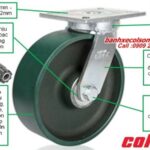Vehicle design load is a crucial factor in bridge and road design. However, many misunderstand this concept, leading to incorrect application of load limit regulations, which hinders transportation and unnecessarily increases bridge construction costs. This article clarifies the nature of vehicle design load and its relationship with actual operating loads.
The Nature of Vehicle Design Load
Vehicle design load is not the maximum permissible load for vehicles traveling on a bridge. It is a theoretical load, determined based on statistical analysis of the impact of actual traffic flow on the bridge structure. The goal is to create a nominal, theoretical load that produces effects on the structure equivalent to those caused by real vehicles.
The process of determining vehicle design load begins with analyzing the load and arrangement of individual vehicles or vehicle trains traveling on the road. These vehicles operate randomly, creating various effects on the bridge structure such as internal forces, deformations, displacements, vibrations, etc. Data on these effects is statistically processed to find the envelope, which is the set of maximum values of these effects.
From this envelope, engineers determine the load arrangement and load values that cause effects in the bridge structure equivalent to (actually much larger due to safety factors and provisions for future load development) the calculated envelope. This load arrangement and load value are the vehicle design load, or design live load.
Vehicle Design Load in Bridge Design Standards
Different bridge design standards specify different vehicle design loads. These can be a series of concentrated or distributed forces, as in the Vietnamese standard 22TCN 272-05, the American AASHTO, the Russian CHnII 84, etc. They can also be single vehicles and hypothetical vehicle trains, as in the Vietnamese standard 22TCN 18-79, the German DIN 1072, the Australian AUSTROADS 1992, etc.
For example, the Vietnamese standard 22TCN 18-79 specifies standard vertical live loads as H30 and XB80 for international routes, major trunk roads, etc., and H10, H13, and X60 for local roads and industrial traffic roads. The H30 load is described as a standard vehicle train consisting of 2 types of 3-axle vehicles with a total weight of 30 tons each, arranged alternately at a certain distance.
Common Mistakes and Consequences
A common mistake is to take the load value in the name of the design load (e.g., H30) as the maximum operating load and post corresponding load limit signs (e.g., 30 tons). This is inaccurate and leads to several negative consequences:
- Restricted Transportation Activities: Vehicles with actual loads less than 30 tons are still prohibited from traveling on bridges designed for H30.
- Increased Construction Costs: Misunderstanding leads to unnecessary increases in design load, increasing the scale and cost of bridge construction.
Incorrect application of load regulations also occurs with other design loads such as H10, H13, etc. It is important to note that vehicles allowed to travel on national roads should also be allowed to travel on provincial roads, except when the vehicle size is incompatible with the limited curve radius of the road.
Conclusion
Vehicle design load is a theoretical concept used for bridge design calculations. It should not be confused with the maximum permissible operating load. Understanding the true nature of vehicle design load is crucial for correctly applying load limit regulations, ensuring efficient transportation operations and saving bridge and road construction costs. The practice of using the design load value to specify operating loads and post load limit signs needs to be stopped.

